The Lincoln Viking 3350 and Miller Digital Elite welding helmets are two popular welding helmets.
These are top of the line and users of both rave about them…
If you are shopping for the best helmet, your choice may well come down to the Viking 3340 or the Digital Elite. It is a tough choice, and the answer depends on the features you value most and how you like to work.
So, to match your needs with the right helmet, you need some details. To make things easy, we have collected the particulars and organized them below into this handy article. Read on to find out which is best for you.
Side by Side Comparison
| Lincoln Viking 3350 | Miller Digital Elite | |
|---|---|---|
| Image | 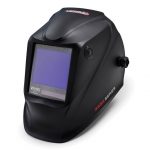 |
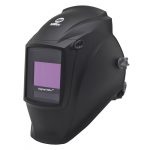 |
| Viewing Area | 12.5 sq. in. | 9.22 sq. in. |
| Arc Sensors | 4 | 4 |
| Shades |
5-13 weld |
8-13 weld |
| Switching Speed (sec) | 1 / 25,000 | 1 / 20,000 |
| Delay Control | 0.1 – 1.0 sec | 0.1 – 1.0 sec |
| Processes/Modes | TIG, Pulsed TIG, MIG, Pulsed MIG, Stick, Flux-Cored, Gouging, Grinding |
Weld, Cut, Grind, X-Mode |
| TIG Rating (amp) | 2 | 5 |
| Clarity | 1/1/1/1 | 1/1/1/2 |
| Grind mode switch | Internal & External | Internal |
| Overhead Welding | ✅ | ⛔ |
| Battery | (1) CR2450 | (2) Pansonic CR2450 |
| Battery Solar Assist | ✅ | ✅ |
| Cheater Lenses | ✅ | ✅ |
| Use w/ Hard Hat | ✅ | ✅ |
| Attachable Lights | ⛔ | ✅ |
| Operating Temp | 14°F to 131°F -10°C to +55°C |
14°F to 131°F −10°C to +55°C |
| Weight | 1.31 lbs | 1.13 lbs |
| Warranty | 3 years | 3 years |
| User Ratings | ★★★★★ | ★★★★★ |
| Price | Latest Price Amazon |
Latest Price Amazon |
Lincoln Viking 3350 (K3034-4)
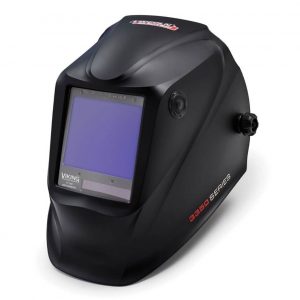
This combination of features makes this helmet ideal for someone who welds, then grinds, and repeats the cycle. It eliminates the constant flipping up or complete removal to adjust the settings/mode. You can simply keep your helmet down and work.
With regards to the clarity, the two helmets are similar, except for the shade at angles rating (the last of the four numbers). The Lincoln rates for better angular performance. If your work involves lots of welding where you cannot look straight at the piece, this may be important to you.
Also, the consumables for this helmet are easier to find. The lens is a standard size you can find in most places selling welding supplies. Plus, the CR2450 batteries from any manufacturer work as replacements.
Expert to novice welders will appreciate the ease of switching from welding to grinding mode, a big viewing area with natural colors, and better angular shade performance offered by the Lincoln Viking 3350.
What’s Included with the Viking 3350
- Helmet
- Helmet bag
- Bandana
- 5 outside cover lenses
- 2 inside cover lenses
- Sticker sheet
Lincoln Viking 3350 Compared to the Miller Digital Elite
Pros
- Larger lens/field of view
- External grind mode switch
- Lenses are standard size, easier to find
- More extras in the box
- 4C lens technology to better see natural colors
- Overhead welding not excluded in manual
Cons
- Dials are small and hard to read
- When in grind mode, there is no clear indicator to remind you, if you forget, you can get flashed when you weld
- The larger lens makes it a little “front” heavy
- No specific “cutting” mode, uses the same shades for welding and cutting
- Heavier
- Sensors must not be obstructed
Where to buy
Latest Price on AmazonMiller Digital Elite (281000)
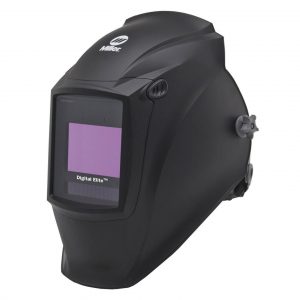
If you are often out of position, or in confined spaces, your sensors may not “see” the arc. Or in bright sunlight, your auto-darkening feature may not turn off when you are not welding. With X-mode, these problems are eliminated, and importantly, you do not risk being flashed.
The Digital Elite helmet also weighs less than the Viking 3350. Both are light in comparison to other helmets on the market, but if you want the lightest helmet between the two, that would be the Miller Digital Elite.
So, if you want the newest technology that protects you against being flashed, and a light helmet, the Miller Digital Elite is your pick.
What’s Included with Digital Elite
- Helmet
- 5 outside cover lenses
- 2 inside cover lenses
- Helmet bag
Miller Digital Elite Compared to the Lincoln Viking 3350
Pros
- Lighter
- X-mode eliminates bright sun interference and darkens lens even if arc sensors are obstructed
- The interface is easy to read at a glance
- AutoSense technology to automatically adjust the sensitivity
- ClearLight lens technology for more natural colors
Cons
- Need to flip up to change to grind mode
- Lenses are a proprietary size
- Need to use (2) Panasonic brand batteries that can be hard to find, other brands do not fit as well
- Not recommended for overhead welding
- Expensive replacement parts
- Maybe a bit more expensive, depending on where you shop
Where to buy
AmazonLincoln Viking 3350 vs Miller Digital Elite: What’s different?
Lens Clarity and Color
The Lincoln Viking 3350 has a perfect 1/1/1/1 rating and it just edges out the Miller Digital Elite. However, both provide a clear view of the puddle, and in the light state, you can see fine. In use, many do give the clarity edge to the Viking 3350.
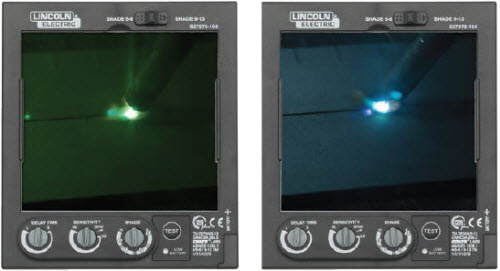
(For those unfamiliar with the lens clarity ratings, the first number refers to the amount of distortion, the second blurriness, the third uniform shade, and the fourth the shade consistency at an angle. The lower the number, the better.)
Both helmets have their own innovations to allow more natural colors to be seen. The Miller product uses ClearLight, while Lincoln uses 4C technology.
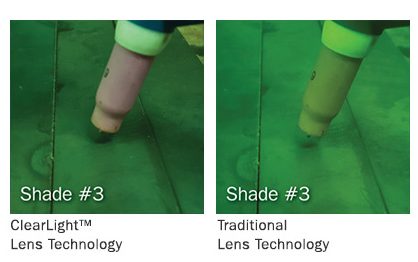
It is also worth noting, the natural colors are better with the Lincoln. You still get a slight green tint with the Digital Elite lens. In contrast, the Viking 3350 has a blue tint while welding, which is more natural.
However, some users claim the blue light tires their eyes faster. It seems some users are very sensitive to light, and the blue tint fatigues their eyes faster.
But many users feel the blue light provides a clearer view without tiring their eyes. For most, there should be no difference between the Digital Elite and Viking 3350 in terms of eye fatigue.
Interface
The two user interfaces sit at the bottom of the lens assembly inside the helmet. The Lincoln Viking 3350 uses dials, while the Miller Digital Elite has an all-digital interface.
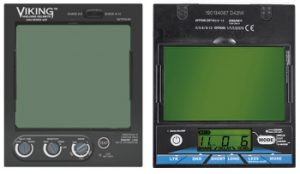
For easy viewing at a glance, the Digital Elite has a clear advantage. The settings are much easier to read, compared to the small dials found on the Viking 3350.
Also, the Viking 3350 has two small lights on the bottom right of the interface. One for grind mode, and one for when the battery is low.
But the grind light on the Viking 3350 could be bigger, or at least more obvious when it is on. If you forget you are in grind mode and miss the small light, you can get flashed if you try to weld. You need to pay attention to what mode you are in with the Lincoln hood.
Related: What is Grind Mode?
Price
It used to be the Miller was more expensive. But these days, the price gap between these two helmets has closed and now there is not much between them,
Also, depending on where you shop, and the specials being run, the price does vary. So, it pays to shop around when you are down to the Viking 3350 and Digital Elite.
Field of View
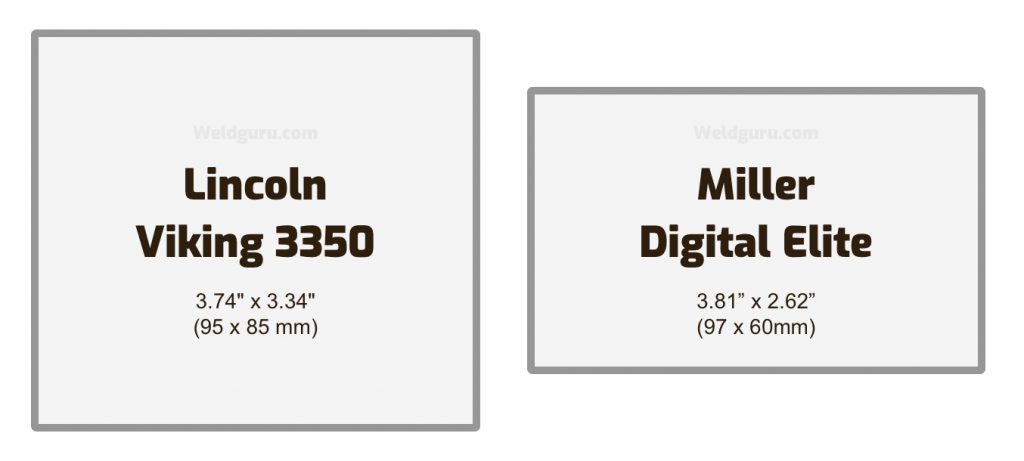
The size of the lens determines your field of view. Not surprisingly, most welders want to see as much as possible.
The Lincoln Viking 3350 is larger by 3 square inches. While the Miller helmet has a good field of view, it is not as big as the Lincoln.
If you do want a Digital Elite level hood from Miller with a larger lens, they do sell another model, the Digital Infinity. It’s slightly heavier, more expensive but has one of largest viewing areas on the market.
Lens Replacement
The size and shape of the lens for the Digital Elite is proprietary. That means you must buy a Miller replacement lens from a supply house that stocks them. They can be hard to find, especially on the weekends or after hours.
In contrast, the Lincoln helmet uses a “standard” lens that you can buy in most welding supply spots. That includes the big box stores. Finding replacement lenses for the Viking 3350 is therefore easier.
Batteries
The Viking 3350 uses 1 CR2450 battery, from any battery manufacturer. In comparison, the Digital Elite uses 2 Panasonic CR2450 batteries.
This may seem a bit odd, but the Miller battery holder does not hold the Duracell or Energizer batteries quite right. The best-fitting battery for the Digital Elite is the Pansonic brand CR2450.
Modes
Lincoln does not state modes like Miller. But the Viking 3350 can weld, cut, and grind. The proper cut and weld shades are referenced in the Lincoln manual, even though they do not specifically have a cut mode in the settings of the helmet.
For grinding, Lincoln includes an external grind switch. You can leave the helmet down, and tap the button to change back and forth from weld to grind mode. You must lift the Miller helmet to access the internal controls to switch modes.
Miller states they include 4 modes in the Digital Elite; weld, cut, grind, and X-mode. X-mode is a significant difference. To keep you from getting flashed, it senses the magnetic field of the arc, independent of the sensors. It also prevents darkening in bright sunlight.
Weight
Both helmets are light in comparison to other choices on the market. But if you need the lightest helmet for all-day work, the Miller is 0.18 pounds lighter.
Overhead Welding
In the user manual, Miller recommends explicitly against using the Digital Elite for overhead welding. While many welders have used this helmet for overhead work, this manufacturer does state not to do it in what appears to be an overabundance of caution.
For the record, Lincoln does not include a similar caution or warning about overhead welding with the Viking 3350.
Included Extras
For those who like a little extra in the box, the Lincoln Viking 3350 does come with a small extra. You get an added bandana, which is not found in the competing Miller helmet package.
Accessories
There are several accessories and consumables for sale for both helmets. For the most part, they are quite similar.
But one add-on is unique to the Miller Digital Elite. You can add external lights. If you work in dark places often, the attachable light accessory may be of interest, enough to push you toward the Digital Elite.
Conclusion
If you have issues with getting flashed due to obstructed sensors, the Miller Digital Elite is the best choice with its X-mode. It darkens on sensing the magnetic field created when you strike an arc. Also, the Miller is the lighter of the two helmets and the user interface is easier to read.
Should you weld and grind often in a day’s work, the Lincoln Viking 3350 has an external grind mode switch. No hunting for goggles, no switching headgear. Also, if you like a clear, big lens with natural color, the Lincoln helmet owns that advantage.
Of course, the other minor differences matter. But the issues summarized here in the conclusion will likely be what drives you to one helmet or the other. Either way, bother helmets are excellent, which is why they make the top of many welding helmet lists.